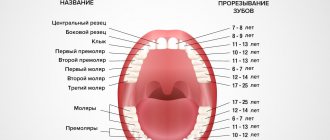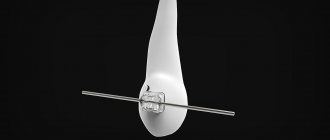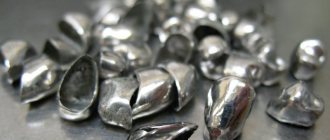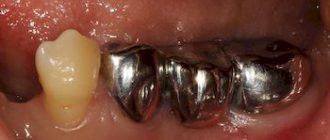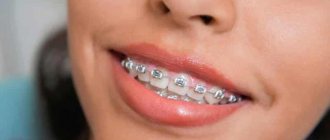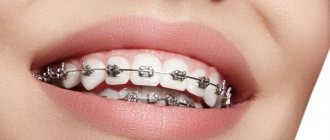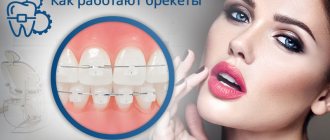Few people decide to undergo orthodontic treatment, believing that it is associated with high costs and discomfort. But often people’s fears are unfounded: installing braces is a multi-step, but safe process that goes without complications. We will tell you how orthodontic braces are placed and what stages this procedure includes.
In this article
- At what age are braces placed?
- Indications and contraindications for installing braces
- How braces are inserted: stages of orthodontic treatment
- How to install braces: diagnosis and treatment plan
- How to install braces: sanitation of the oral cavity
- Is it possible to put braces on crowns and fillings?
- How to install braces
- How to install braces: stages of the procedure
- Does it hurt to get braces?
- Braces activation
- How braces are placed on children and adults - is there a difference?
- How to care for braces
- How are braces removed?
Braces are installed primarily to correct the bite or straighten unevenly growing teeth. According to statistics, about 75% of children have problems with bite. If they are not eliminated in childhood, they will affect the health of teeth and gums in the future. In addition, people with malocclusion and irregularities in the dentition often develop complexes, lower self-esteem and, as a result, have difficulties in building interpersonal relationships.
Today, this problem can be solved in just a few years; you just need to install braces - dental brackets that are fixed to the dentition from the inside and/or outside and gradually straighten the teeth to a normal state. There are many rumors and myths surrounding the topic of orthodontic appliances.
Many people believe that getting braces is dangerous and painful, they cause discomfort, interfere with eating normally, etc. Such ideas are generated by ignorance. We'll tell you how braces are installed and how the preparation for their installation goes.
At what age are braces placed?
Braces are placed on both children and adults. Dentists say that the optimal age for orthodontic treatment with braces is 12-13 years. During this period, the final formation of the bite and the replacement of milk teeth with molars occurs. Pathologies in the structure of the dental system discovered in a teenager are eliminated faster than in adulthood.
In some cases, braces are placed earlier - at 8-11 years. However, if a person has missed this point, he can correct the problem as an adult. Of course, the treatment process will be longer, but no less effective. There is no upper age limit as such: an adult can be prescribed to wear braces as long as he has teeth, and bite correction is justified in terms of indications and contraindications.
Approximate cost of treatment with braces
As an example, let’s take the cost of treatment with a metal brace system. When using, for example, a ceramic braces system, the difference will only be in its cost (initial stage). Let's consider a case of medium complexity, standard alignment of two rows of teeth, without the use of microimplants.
We will carry out the calculation using our price list table and average prices for services on the Internet. We believe that the oral cavity is completely sanitized - this is a prerequisite for starting treatment with braces.
Indications and contraindications for installing braces
Braces are placed to eliminate the following dental problems:
- malocclusion;
- uneven development of the jaws;
- anomalies of individual teeth;
- deformation of the dentition;
- chewing dysfunction;
- impacted teeth;
- large interdental spaces.
Contraindications to wearing braces can be absolute or relative. Among the first, which completely exclude the possibility of installing an orthodontic structure, are:
- absence of most of the teeth;
- some oncological pathologies;
- blood diseases;
- diseases of the endocrine system;
- very weak immunity;
- pathologies of the skeletal system;
- tuberculosis and HIV;
- psychiatric disorders.
Relative contraindications are temporary. These include:
- periodontal disease;
- caries;
- wounds in the oral cavity;
- metal implants;
- poor hygiene.
Braces can be placed only if the listed factors are eliminated. Indications and contraindications are identified during diagnosis - the first stage of installing orthodontic brackets.
Preparatory activities
Before fixing braces, it is necessary to prepare the oral cavity. For this purpose, rehabilitation is carried out. It is aimed at eliminating accumulations of plaque and stone. At the same time, existing dental diseases are treated. If any chronic pathologies are identified, they are transferred to the remission stage.
Before installing the device, be sure to treat:
- caries;
- pulpitis;
- gingivitis;
- periodontitis;
- periodontal disease;
- root cyst;
- periostitis;
- stomatitis.
If there are partially destroyed tooth crowns, they are restored in advance with composite material. If necessary, intracanal pinning and installation of artificial crowns are performed. Those units that cannot be treated are removed.
Particular attention is paid to professional oral hygiene. During this process, an ultrasonic scaler is used. This device works by performing oscillatory vibrations.
It seems to knock off hard deposits from the surface of the enamel , due to which the latter is completely cleaned and becomes absolutely smooth. This means that the upcoming fixation of braces will take place without complications. Also, after a hygiene procedure, the number of pathogens in the mouth decreases and reduces the risk of gum inflammation.
How braces are inserted: stages of orthodontic treatment
The process of installing braces, that is, fixing them on the teeth, lasts about 1.5-2 hours. Preparation takes much more time. In general, treatment includes the following steps:
- Diagnostics: obtaining x-rays, on the basis of which braces will be made.
- Drawing up an individual treatment plan, advising the patient on preparation for the procedure.
- Sanitation of the oral cavity, treatment of diseases of the teeth and gums: caries, inflammatory processes, etc.
- Installation of an orthodontic structure, fixing it on the dentition.
- Assistance in adaptation: doctor’s recommendations regarding nutrition and care of teeth and braces during the treatment period.
Let's look at these stages in more detail.
The first stage is diagnosing the problem
The preparatory stage begins with a consultation between the patient and the orthodontist. The specialist conducts a thorough diagnosis of the dental system, identifies problems with occlusion and suggests a correction method ( read : how to straighten teeth without braces). In some cases, braces cannot solve the problem and surgery may be required.
The orthodontist uses the following diagnostic methods:
- — visual inspection using dental instruments;
- — orthopantomogram (panoramic photograph of the jaws);
- — teleroentgenogram (lateral image of the jaw bones);
- — photo of the patient’s dentition and face;
- - X-ray examination;
- - CT scan.
If necessary, allergy tests for materials are performed. Additional examination of problematic teeth may be required to make a diagnosis. The study is carried out using advanced equipment, which allows you to accurately visualize the patient’s dentition.
Leonid Gorbunov's clinic has all the necessary equipment. You can undergo the examination directly in the clinic with your attending physician.
How to install braces: diagnosis and treatment plan
Diagnostics allows you to identify contraindications, assess the condition of teeth and gums, take pictures and develop a further treatment plan. After the diagnostic examination, approximately a week passes, during which the doctor analyzes the material and draws up a plan for installing orthodontic structures. There may be several such plans and they differ in the method of fixing the braces or their type. The patient has the right to choose one of the proposed treatment options. Then the next stage begins - preparing the oral cavity for installation of the structure. Its duration is determined by the condition of the teeth and gums.
Our team of doctors
Maxillofacial surgeon, Implantologist
Bocharov Maxim Viktorovich
Experience: 11 years
Dental surgeon, Implantologist
Chernov Dmitry Anatolievich
Experience: 29 years
Orthopedist, Neuromuscular dentist
Stepanov Andrey Vasilievich
Experience: 22 years
Endodontist, Therapist
Skalet Yana Alexandrovna
Experience: 22 years
Orthopedic dentist
Tsoi Sergey Konstantinovich
Experience: 19 years
Dentist-orthodontist
Enikeeva Anna Stanislavovna
Experience: 3 years
Metal braces
Standard and reliable equipment for correcting jaw and dental disorders of any complexity. There is little aesthetics here because it stands out against the background of the teeth enamel. The lack of aesthetics of the design is compensated by the quick and high-quality achievement of the result. Implantmaster uses self-ligating metal plates from the Damon model range.
Pros:
- correct pathologies of varying severity;
- daily hygiene care is very simple;
- reasonable price;
- strength (the highest among orthodontic plates);
- the color of the equipment does not change under the influence of food;
- short treatment periods.
Minuses:
- Injury to the soft tissue structures of the oral cavity and tongue is possible.
- Noticeable when smiling or talking. Some patients refuse this model due to aesthetic discomfort.
- Allergies may occur.
Ceramic braces
The shade of such equipment matches the enamel of the teeth and is almost invisible during conversation. For the smile zone or for all units, taking into account the opinions of patients, Implantmaster specialists can offer a self-ligating system made of Damon Clear ceramics. She is in great demand.
Pros:
- Productivity. Installed to correct severe pathologies of jaw closure.
- Does not stain when worn for a long time, taking into account all the rules of hygienic cleaning.
- Few doctor visits are necessary.
- Resistant to loads.
- Aesthetics and comfort throughout the entire course of treatment.
Minuses:
- Therapy takes longer than with metal equipment.
- The cost of the system is several times higher than that of a metal structure.
- The need for thorough cleaning of equipment and the oral cavity. It is not advisable for children and adolescents to record.
- An allergic reaction may occur.
Sapphire braces
Which braces are better: sapphire or ceramic? When choosing between these two categories of wafers, sapphire wafers are the best option. They perfectly combine aesthetics and durability. The components of the bracket system are made of artificial sapphire - a very durable, non-toxic and biocompatible material. The plates do not change color when exposed to food or drinks, tobacco, coffee or wine.
Recommended for installation when there are wide gaps between units and lack of space in the dentition.
Pros:
- Highly aesthetic (matches the natural shade of enamel).
- Does not stain.
- Does not cause discomfort.
- Does not damage soft tissue structures of the oral cavity.
- The pronunciation of sounds is not affected.
Minuses:
- The material itself is durable, but the plates can break due to crackers or chewing gum.
- Unpleasant sensations may appear when the gums are sensitive.
- Effective only in simple deviations.
- The course of treatment lasts longer than usual.
- Need special care
Invisible (lingual) braces
Fixation is carried out on the enamel of the teeth from the oral cavity (lingual). It turns out that the main positive feature of such systems is their concealment from others. The plates are invisible when talking and smiling.
Additional positive characteristics:
- Small size. Throughout the course of therapy, the patient does not experience discomfort, because adaptation to the plates occurs quickly.
- Application of 3D technologies. When installing the system, it is more convenient for a specialist to fix the plates and control the movement of units, as well as the correction of general pathology. Already when planning a treatment regimen, a doctor with extensive experience can imagine the step-by-step movement of units along the jaw model.
Negative:
- Compared to other equipment, pain is higher when moving units.
- Problems arise when speaking and pronouncing sounds. Logoneurosis may develop due to worries about speech disorders.
- There is a high risk of injury to the soft tissue structures of the oral cavity and tongue.
- The treatment period is much longer than that of the vestibular systems.
- Expensive.
Ligature-free braces systems
What are the best braces? Most specialists and patients consider self-ligating systems to be the best choice, regardless of their high cost. They do not include additional fasteners, which makes them more discreet when talking. Self-ligating equipment is universal and suitable for all patients with clinical cases of varying complexity.
Pros:
- various plate materials (ceramics, metal, plastic, sapphire);
- quick addiction;
- effectiveness;
- comfortable course of treatment;
- smooth movement of units due to the use of small forces from the arc;
- resistance to color change;
- visit a specialist once every 2 months.
Minuses:
- lack of results in severe pathologies of the maxillofacial area and temporomandibular joint;
- high cost.
How to install braces: sanitation of the oral cavity
After installing braces, the procedure for brushing your teeth becomes noticeably more complicated and the risk of developing caries increases. To reduce it to a minimum, you need to eliminate all carious cavities. The main task of the dentist is to identify hidden foci of pathology that are located in the interdental spaces.
It is also necessary to eliminate inflammatory processes if they were detected during diagnosis. In other words, it is necessary to cure those pathologies that may become more complicated after installing braces. In addition, at the preparatory stage, ultrasonic cleaning is carried out, during which plaque and tartar are removed.
Some patients are worried that they will have to remove some teeth: “eights”, impacted ones, etc. Extraction is indicated in the following cases:
- crowded teeth;
- teeth that are too large (free-standing);
- presence of extra teeth;
- severe asymmetry of the jaws;
- decaying teeth that are useless to treat.
As a rule, if removal is necessary, it is wisdom teeth, which often erupt with complications: they grow to the sides, remain partially or completely in the gums and subsequently cause malocclusion.
Content:
- Preparatory activities
- Options for installing braces 2.1. Direct method 2.1.1. How it goes 2.1.2. Advantages and disadvantages 2.2. Indirect method 2.2.1. Advantages and disadvantages
What result will be obtained after fixing braces depends on many factors. But the most important thing is that the installation of the leveling structure is done correctly. If you fix the device incorrectly, the teeth will close at the wrong angle. Then there will be no need to talk about any correction of the bite, no matter how long the patient walks with an “iron smile.”
Is it possible to put braces on crowns and fillings?
Adults, even if they take excellent care of their teeth, have had caries at least once in their lives, so there are almost no patients without fillings or crowns. Their presence is not a direct contraindication to the installation of braces. Modern compounds from which fillings are made form a monolithic structure with dental tissues, so they do not fall out or collapse. They are replaced only if they were installed long ago or incorrectly.
As for crowns, they may require the installation of metal braces, which provide a more reliable and durable fixation. Thanks to this, the crown will be protected from external influences.
How much does it cost to install braces (for 2 jaws) –
1) Consultation with an orthodontist is usually free. 2) Diagnostics (taking and making impressions, analysis of control diagnostic models, calculation of TRG, analysis of orthopantomograms, which are necessary to draw up a treatment plan) - from 5,000 rubles.
3) Metal ligature braces −
- “Marquis” – price from 100,000 rubles,
- “Forestadent Sprint” – from 120,000 rubles,
- “Forestadent Mini-Sprint” – from 145,000 rubles,
- “Victory” – from 160,000 rubles.
4) Metal self-ligating braces −
- “Forestadent Quick” - from 125,000 rubles,
- “Damon Q” − from 155,000 rubles,
- “In-Ovation R” - from 160,000 rubles,
- "Empower" - from 160,000 rubles.
5) Ceramic braces −
- ligature - price from 125,000 to 160,000 rubles.
- non-ligated (self-ligating) - price from 140,000 to 220,000 rubles.
6) Braces made of artificial sapphire −
- ligature braces “Pure” – price from 125,000 rubles.
- ligature “Inspire-ICE” – price from 160,000 rubles.
- non-ligature “Damon clear” – price from 180,000 rubles.
7) Lingual braces −
- In-Ovation-L braces – price from 230,000 rubles,
- WIN braces – from 280,000 to 300,000 rubles,
- Incognito brand braces - from 450,000 to 500,000 rubles.
 Braces correction session (carried out once every 1-2 months) – from 1600 to 3000 rubles. Read more about prices for different braces options using the relevant links above.
Braces correction session (carried out once every 1-2 months) – from 1600 to 3000 rubles. Read more about prices for different braces options using the relevant links above.
How to install braces
Braces are installed in two ways: direct and indirect. The essence of the first method is as follows: the clasps of the structure are glued onto each tooth crown using special dental cement and glue. Next, an arc is threaded through them. After fixing the braces, any remaining adhesive is removed.
When using the indirect technique, a plaster model of the patient's jaws is prepared. The dentist places locks on it, and then transfers the finished structure into the patient’s oral cavity. The entire mechanism is glued to the teeth in one go. This method can significantly reduce the procedure time - up to 30-40 minutes. This is about an hour faster than direct installation. Since the patient has to sit with the jaw expander in his mouth all this time, the difference is quite noticeable.
Instructions for making braces
How to make braces? Not very difficult. You can make devices from available items.
Here is a list of materials that will be needed during the process:
- Large size paper clips.
- Wire.
- Paper plate or other convenient surface.
- Sandpaper.
- Super glue.
- Pliers.
- Orthodontic wax.
- Beads (preferably different colors).
- Earrings in the shape of a butterfly.
So, let's describe the technology of how to make braces at home.
Braces at home from a paper clip
- Bend the object into a straight line.
- Make the paperclip into the shape of a tooth row, that is, bend it in a U-shape.
- Go to the mirror and stretch your mouth into a smile. Assess how many teeth are visually visible. By counting them, you will find out how many beads you will need in the future.
- Take the beads and attach them to the paperclip. Remember to maintain the correct distance between objects, equal to the distance between the teeth. The beads should be located directly in the center of the tooth. Now raise the paperclip to your teeth and smile widely. Evaluate what has been done.
- Place the paper clip on the paper surface and glue the beads to the wire with non-toxic glue. The beads should stick very well to the paper clip. There should be enough glue. During gluing, the beads and paper clip should not stick to the paper surface. If excess glue suddenly forms, it must be carefully removed from the wire. Average holding time of a glued structure: 4 weeks.
- Make the beaded paperclip into an L shape using pliers. Make folds on both sides. At the same time, try to achieve a level base. Be patient and do the folds slowly.
- Take orthodontic wax (you can find it in pharmacies.) Make two balls from it. Thread the ends of your homemade braces through these balls. For fastening, in addition to wax, you can use chewing gum.
- The structure is ready. Secure it to your teeth for a comfortable feeling.
Sequence of making wire braces
- Take silver craft wire. Give it a U shape.
- Make hooks from the ends of the wire for fastening using pliers. In this case, there is no need to bend them until the very end.
- Choose a suitable elastic band. Find a rubber band that is not too thick and is long enough that it stretches across all the front teeth.
- Attach the elastic band to the wire. Perform movements carefully so as not to damage the structure. Hang the elastic on one hook, pull it tight and secure it on the next side. Squeeze the hooks using pliers. The elastic band should hold very tightly.
- Take small earrings that look like a butterfly. Number of earrings needed: 6. Attach this number. In this case, the back of the earrings should be on the wire.
- Make a fitting to align the butterflies. After assessing the result, make the necessary movements so that the earrings are in the center of the teeth.
- Prepare brackets for the bottom row. The execution sequence differs little from creating braces for the top row. The only thing you won't need to do is attach butterfly earrings. The quantity made will be enough for the aesthetic appearance of the structure.
How to install braces: stages of the procedure
Braces can be vestibular and lingual. The former are attached to the outside of the teeth, the latter - from the inside. Regardless of what structures are installed, the procedure is carried out according to the following algorithm:
- the patient’s lips are lubricated with cosmetic Vaseline, after which a dilator is inserted into the mouth;
- saliva is removed from the oral cavity using a special tube;
- Glue is applied to the teeth, and medical cement is applied to the clasps that are attached to the enamel;
- Under the influence of an ultraviolet lamp, the cement and glue harden, as a result of which the clasps adhere to the tooth surface.
If the installation is direct, an arc is threaded through the clasps. Indirect fixation involves transferring the finished structure into the patient’s mouth. The arc has a memory effect. Gradually, she returns to the shape that was given to her during the preparation of braces and straightens her teeth.
What it is?
Braces are essentially just that part of the bracket system that is attached to the tooth, a bracket for attaching a steel arch (wire). In addition to auxiliary fittings (springs, ligatures, rings) for fixing and tensioning the wire, a bracket system is formed.
The sooner you see an orthodontist, the better, but there is no age limit for use.
The essence of braces is to correct bite defects that lead to wear and destruction of tooth enamel, the appearance of caries and a decrease in aesthetic perception:
- protruding lower or upper jaw,
- uneven overlap,
- curvature of the dentition.
Does it hurt to get braces?
Pain during the procedure can only occur if the enamel and teeth are sensitive. If necessary, the doctor will give an anesthetic injection. Once braces are in place, a person may experience discomfort, especially when chewing food. Usually he feels pressure on his jaw, but, as a rule, there is no severe pain that needs to be relieved with medication. Adaptation to braces occurs within 5-15 days, depending on the condition of the teeth.
Resilines fastening system
Fixing Resilines braces is another modern method practiced in dentistry. This is the most popular adhesive for attaching braces. Its adhesive properties are very soft and sticky, ideal for bonding any type of overbite correction. Using the composition it is possible to fix metal, sapphire and ceramic products. The adhesive quickly hardens under the influence of ultraviolet lamps. But until the braces are glued and the locks are installed, it remains soft. The metal arch can be installed immediately after attaching the locks.
Regardless of the chosen method, the orthodontist, first of all, needs to focus not on the method of fixation and type of brace system, but on the doctor’s expertise. With the right approach, any of the methods will be effective.
Braces activation
Immediately after installation, the braces are activated and begin to correct the bite and irregularities. Gradually, the pressure of the arc will weaken due to the displacement of the teeth. Periodically you need to visit the orthodontist in order to tighten the structure and increase the tension. This will continue for 1-3 years until the dental problem is completely eliminated.
Conclusion
Installing braces is a complex multi-stage process that requires precision, high qualifications and professionalism from the dentist. Different brace systems have differences in installation. To ensure that the procedure is quick and comfortable, it is important to choose a clinic with a good reputation. Leonid Gorbunov's dentistry employs responsible orthodontists with extensive experience, so the effectiveness of treatment is guaranteed.
Installation video
Posted by:
How to care for braces
To reduce the likelihood of developing dental diseases, the patient will have to carefully monitor their diet and oral hygiene. In particular, it is necessary to avoid hard and sticky foods, foods with dyes and smoking. If possible, you should limit your consumption of sweets. For oral care you should purchase:
- a brush with V-shaped bristles (CURAPROX Ortho);
- brush (Curaprox CPS 10, Biorepair Scovolini Interdentali Cilindrici);
- dental floss (Mirafloss implant chx);
- rinse aid with antibacterial properties (Biorepair Mouthwash).
It is advisable to use toothpastes without abrasive substances and periodically (2-3 times a week) clean the oral cavity with an irrigator. To do this, purchase devices that are suitable for caring for orthodontic structures: Little Doctor International Ltd Aquajet LD-A7, Donfeel Donfeel OR-820D Compact, Revyline RL100, Donfeel Donfeel OR-888, Panasonic EW-1411, Revyline RL 200XL, etc.
Rinse aids
To ensure that cleansing procedures remain effective throughout the day, patients wearing braces must use special rinses and solutions.
They contain antibacterial substances of natural origin, which reduce the proliferation of bacteria and prevent the occurrence of inflammatory processes.
Mouthwashes are made on the basis of strengthening and anti-caries substances, which results in the improvement of tooth enamel and the prevention of the development of oral diseases.
How are braces removed?
Dismantling of the structure is carried out in the dentist’s office and is carried out in several stages:
- using a special tool, the locks are unfastened;
- the arc exerting pressure is disconnected from the locks;
- each lock is removed using tweezers;
- Solvent removes remaining glue from the enamel.
To consolidate the results of treatment, the patient wears a plate for 2-3 weeks to straighten the teeth and protect them from stress. Immediately after removing braces, ultrasonic cleaning or whitening can be performed.
Comparison of performance of different braces models
To make the right choice - which braces are best to install to straighten teeth - it is recommended to find out the characteristics of various systems and their varieties.
By type of fixation:
| Sign | Vestibular braces | Ligature |
| Efficacy of therapy | High performance | To have an effective effect, you need a suitable clinical situation |
| Duration of treatment, years | Treatment periods take up to 2 years | Treatment takes from 2 to 3 years |
| Design reliability | High structural strength | Structure and appearance depend on external stimuli |
| Popularity | The choice of many specialists and patients | Rarely fixed due to inappropriate cost |
| Aesthetic component | Average aesthetics | Invisible to others |
| Difficulty of fixation | Easy to install | Installation difficulties |
| Hygienic care | Standard hygiene products required | Difficult to maintain hygiene |
| Adaptation period | Getting used to it takes 2 weeks | Adaptation can take up to 3 months; it happens that the patient needs to install another system |
| Wearing comfort | Convenience | Inconvenient |
| Presence of pain | Painless when wearing | Soreness |
By comparing the characteristics of equipment made from different materials, you can understand which braces are better: ceramic or metal.
Metal plates start at a cost of 80 thousand rubles, show high results even with severe deformations, but they are difficult to clean. The main disadvantage is that they attract attention when communicating.
| Characteristic | Classic self-ligating braces | Invisible (lingual) braces |
| Visibility | Visible due to the contrast with the enamel shade | Invisible to others |
| Convenience | May damage soft tissues | Causes diction problems |
The cost of ceramic systems starts from 110 thousand rubles. Such plates are very fragile and require careful hygienic cleaning.
| Characteristic | Classic self-ligating braces | Invisible (lingual) braces |
| Visibility | Invisible in conversation and when smiling | Invisible to others |
| Result in severe cases | Effective in a large number of pathologies | Coping with even the most severe clinical cases |
| Convenience | Discomfort occurs only in the first 7 days | After the adaptation period, you can avoid injury if you follow all the specialist’s recommendations |
Rubber bands
These devices are used when wearing ligature systems and serve as small rods to set uneven dental units in the correct direction.
They are made in the form of small rings from an elastic material and have a smooth surface. This device is suitable for absolutely all patients and does not cause allergic reactions.
Elastic bands serve not only as an auxiliary element when wearing an orthodontic apparatus, but are also used as a decorative means. On sale you can find elastic bands of various shades, which allows you to make a choice based on the individual preferences of the patient.
You should not ignore the recommendation of a specialist on wearing rubber bands. This device is the key to effective and quick correction of the bone organs of the oral cavity.
Types of systems by fixation method
Corrective structures are fixed on the tooth surface in different ways - this is another sign for their conditional classification. Whatever material the braces are made of, they can be ligated or non-ligated. In the first case, the arch is attached to the clasps using elastic rings (ligatures). In the second option, we are talking about self-ligating systems - the arc is inserted into a special groove with a lock.
Ligature braces
The ligature system consists of a metal arch, the actual braces and connecting individual elements. The effectiveness of classical models is based on the ligature - an element of the bracket system, which is a thin metal wire.
These systems have a high degree of functionality, and in some cases, only the use of a ligature system can lead to the elimination of bite defects. If a ligature system has been chosen for treatment, then a mandatory monthly visit to the orthodontist is necessary.
Non-ligature braces
Today, manufacturers of orthodontic systems have developed self-ligating (ligature-free) braces for more comfortable treatment of patients. Due to the absence of ligatures on the locks, which are subject to deformation, visits to the orthodontist are reduced by one and a half to two times.
Externally, the self-ligating design looks neater and more attractive. The size of the locks in these systems is slightly smaller than in conventional classic systems.
In addition to the fact that non-ligature braces allow you to visit the doctor less often and look more attractive, their very effect on the teeth is softer and more gentle in comparison with ligature systems.
Removable appliances (braces)
In practical dentistry, bite correction is often carried out using removable structures. In the treatment of adults, they are not as effective as in children’s occlusion, since the complete formation of the skeletal system has already occurred.
Types of removable structures include trainers, aligners, and mouth guards.
One should not expect a radical solution to the problem of correcting the bite from such systems: they are effective only for minor curvatures or for solving the problem of jaw expansion, when the issue of lack of space for teeth arises.

